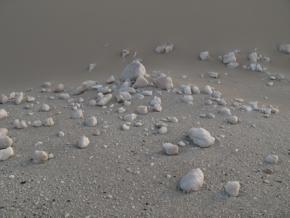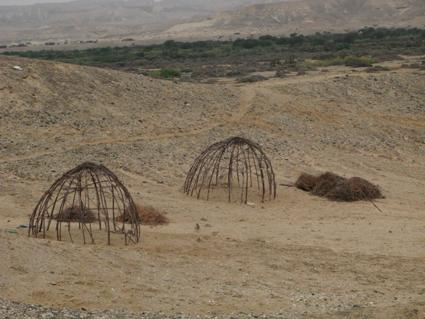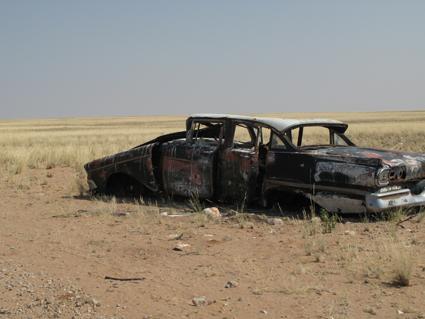Desert Travel: Namibe, Angola
Excerpt from the book Desert Travel: Namibe, Angola by Cristina Salvador and Cristina U. Rodrigues, published by IPAD in September 2010, and dedicated to Ruy Duarte de Carvalho.
Return
We have reached the end of the trip. We sought afterwards to fill our imperfect knowledge of that desert with information produced about that area throughout time. Information that we were looking for always intersecting with the excitement of what we lived during the journey. In the space/time game that rules our lives, this trip marked a compass that appears and disappears as if it had no end.
 Fotografia de Cristina Salvador
Fotografia de Cristina Salvador
We had little knowledge of the forces of nature that are the source of that desert, of their size and the breadth of their influences. On the other hand, we were also torn by the contrast between the horizon, which extends beyond all that is visible, and interest in the detail of a stone, or the simple proof of human passage. Recalling Paul Theroux’s similar difficulty in Back to Patagonia, to be forced to choose between the miniscule and the endless, for there is no intermediate zone of study there, we were also torn between the vastness of the desert and of observation of welwitschia; or between the recognition of transhumance that characterizes the population of that area and the allure of testimonies of attempts at sedentarization; and finally between the present which actually lives there and the history of the past we seek to reecounter.
We understood then that the desert is a place of passage that can also be referred to as a space for creation or punishment. In Western culture it has been identified throughout time as a place of reecounter with one’s self or as a space of transcendence; it has also been appointed the place where monotheistic religions originate (Debray, 2002:66):
“In fact, in the Old Testament, the desert is as magnetic as it is repulsive. It is charged with ambivalence: it is the punishment of Adam and the salvation of Moses, place of trial and space of temptations, the gloomy abode of the dead near the schéol. Never indifferent: it either revives or causes death. It is the chaos before the creative act, prior to the rains of the third day, preceding the well-watered garden of Eden. It is also the dust to which man will return in fine” (Debray, 2002:66).
On the issues of development or planning that arise in that area, we think it is necessary to begin from a deep knowledge of that territory and what happens there. This need for knowledge that pushed us to this journey continues, has not ended in any way in this writing. I can say, perhaps, that this trip has increased our awareness of the uncontrollable aspects of nature (the Icelandic volcano has now served notice to the oblivious) and revealed to us the existence of populations that are able to combine complex social organization and ownership of simple natural resources, which can only be the result of their deep knowledge of the territory. We realized that, strangely, in the desert, everything has come to be recorded, and that those who would be careful and lucky can sometimes see, between mirages, dinosaur fossils, crossings of fugitives, forced labor, cave paintings, windmills… At times, the sand comes and covers them, but later the wind wipes them clean, until the sand begins to cover again. At the end of this journey, we returned to the starting point.
Cristina Salvador.
 Fotografia de Cristina Salvador
Fotografia de Cristina Salvador
You never return from the desert. The trips are steps of cyclical returns, they begin to make sense when you return to a place you have been before. The visits to Namibe were also like that, in both the physical revisitation, as well as revisiting the texts and existing information about Namibe. But, while the landscapes and people recreate their own ways over time - including the time of return visits - the texts remain fixed in the dates and ideas that created them. The more updated they are, the more they will be able to give an account of the changes. One of the major challenges involved in an understanding of Angola is precisely to produce new texts, new records of reality that consider the transformation of its landscape and people. The changes in recent years were not insubstantial, if we start from the moment they began to be recorded on paper: colonization, decolonization, independence, almost always war.
Although the desert is old, one of the oldest in the world, which has retained virtually the same characteristics over thousands of years, the people of Namibe are changing: in the way they live and relate, in ways that fit the landscape itself, where it remains the same and where it changes. The most rapid changes happen in the cities, in what they generate back into the desert landscape and the way they influence the spaces that are not city. The city itself is also potentially a desert.
The people of Namibe are very accustomed to change, to adaptation. The desert asks of its beings, living and inanimate, a joint effort with the landscape and how it is organized. One of the most remarkable features of these ancient people is the ability to integrate change, leading to unprecedented social and cultural productions, originating from various parts of Africa and the world. Hence, some of the difficulties ethnographers have, and sometimes even more so, those seeking an ethnic or linguistic or cultural authenticity that would be neat and compartmentalized. This difficulty in cataloging the people of Namibe is not, however, reason to shrug off an understanding of their current characteristics and how they have been changing throughout recent times. Leaving them shut in the pigeonholes of old writings can not only contribute to a growing invalidation of all that was written and described so far - because it is increasingly difficult to recognize the reality of today in what was written in the past - but also contributes toward a loss of the narrative of everything that has happened since those writings from the colonial era to the present. Fortunately, in Namibe, Ruy Duarte de Carvalho accompanied the evolutions. Replacing the information on a series of other stops still remains.
Cristina U Rodrigues.
 Fotografia de Jorge Ferreira
Fotografia de Jorge Ferreira